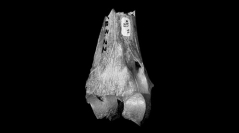

 Comptes Rendus Palevol
7 (8) - Pages 571-581
Comptes Rendus Palevol
7 (8) - Pages 571-581The fossil vertebrate bearing locality Kossom Bougoudi (KB) is situated in the Djurab desert (Chad, Africa), 600 km north-east of N’djamena. It has yielded about 1250 specimens with many mammalian remains, principally artiodactyls. Its geologic age has been estimated to be about 5 Ma by biochronologic estimation and about 5.3 Ma by radiometric studies on cosmogenic nuclides of beryllium (authigenic 10B/9B). The carnivoran fauna contains few specimens which belong to five different families. All the taxa were unknown in central Africa. A large lutrine is close to Sivaonyx but different from known species of the genus. Another large lutrine is similar by its size to a species described from the Middle Pliocene of Uganda. An edentulous mandible of a small machairodont cat resembles a small species of Dinofelis, while a distal humerus indicates the presence of a larger member of the same genus. A hunting hyaenid is also much like the European species. An unidentified canid reaches the size of the recent Canis aureus and an isolated calcaneum matches that of the large extant viverrid. This small fauna allows a first look at the guild of the carnivorans at the Latest Miocene–Pliocene boundary in Central Africa and is a milestone between North African, East African and South African carnivore faunas.
Carnivora, Miocene, Pliocene, Central Africa, Mustelidae, Felidae, Hyaenidae, Canidae